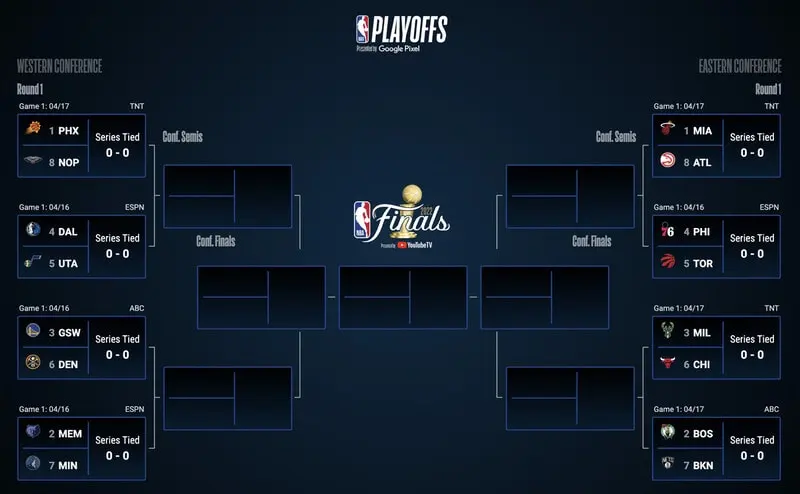Each spring, the NBA Playoffs bring high-stakes basketball to center stage, as the league’s best teams compete for a shot at the championship. But how many teams actually qualify, and how does the modern playoff structure work?
Today we’ll breakdown the 2025 NBA playoff format in detail, from the number of teams that make the postseason to how each round plays out, so fans can follow the action with full understanding.
1. How Many Teams Make the NBA Playoffs?
Total Number of Teams
As of the 2025 NBA season, a total of 16 teams officially make the NBA Playoffs: 8 from the Eastern Conference and 8 from the Western Conference.
However, the path to the playoffs has evolved in recent years. Starting with the 2020–21 season, the NBA introduced the Play-In Tournament, which effectively expanded the number of teams with a chance to qualify.
Quick Breakdown:
| Conference | Teams in Playoffs | Teams in Play-In | Total Involved |
|---|---|---|---|
| Eastern | 6 automatic + 2 via play-in | Seeds 7–10 | 10 |
| Western | 6 automatic + 2 via play-in | Seeds 7–10 | 10 |
| Total | 16 playoff teams | 8 play-in teams | 20 teams |
So while 16 teams ultimately make the playoffs, 20 teams participate in postseason contention thanks to the Play-In Tournament.
2. The NBA Play-In Tournament
Introduced to increase competitiveness, the NBA Play-In Tournament is a mini-tournament held after the regular season and before the playoffs.
Who’s Involved?
The 7th through 10th seeds in each conference participate:
- 7th seed
- 8th seed
- 9th seed
- 10th seed
Play-In Format:
The format is straightforward but strategic:
- Game 1: 7th vs. 8th seed
- Winner earns the 7th playoff spot.
- Loser gets a second chance.
- Game 2: 9th vs. 10th seed
- Loser is eliminated.
- Winner advances to play the loser of Game 1.
- Game 3: Final Play-In Game
- Winner of Game 2 vs. Loser of Game 1.
- Winner claims the 8th playoff spot.
This ensures a double-elimination advantage for the 7th and 8th seeds, rewarding better regular-season performance.
3. NBA Playoffs Format: The First Round
Once the final 8 teams from each conference are determined (including two from the Play-In), the traditional NBA Playoffs begin.
First Round Structure:
- 8 teams per conference
- Matchups based on seeding (1–8)
Seeding Matchups:
| Seed | Opponent |
|---|---|
| 1 | 8 |
| 2 | 7 |
| 3 | 6 |
| 4 | 5 |
Series Format:
Each series is a best-of-seven format:
- First to win 4 games advances.
- Games follow a 2-2-1-1-1 home/away format:
- Higher seed hosts Games 1, 2, 5, and 7 (if necessary).
- Lower seed hosts Games 3, 4, and 6.
4. Conference Semifinals: The Second Round
Teams that win their first-round matchups advance to the Conference Semifinals—the second round of the playoffs.
Structure:
- 4 teams per conference remain.
- Matchups are determined by seeding (highest vs. lowest).
Example (if higher seeds win):
- 1st seed vs. 4th seed
- 2nd seed vs. 3rd seed
Format:
- Best-of-seven series
- Same 2-2-1-1-1 home-court format as the first round.
5. Conference Finals: The Third Round
The winners of the Conference Semifinals face off in the Conference Finals—the final stage before the NBA Finals.
Matchups:
- Only 2 teams per conference remain.
- The winner is crowned Eastern or Western Conference Champion.
Importance:
The Conference Finals are often some of the most intense matchups, as top-tier teams battle for a spot in the NBA Finals.
Format:
- Best-of-seven
- Higher seed retains home-court advantage.
6. NBA Finals: The Ultimate Showdown
The climax of the NBA season is the NBA Finals, where the Eastern Conference Champion meets the Western Conference Champion in a showdown for the championship.
Format:
- Best-of-seven series
- Home court is awarded to the team with the better regular-season record.
Example Schedule (2-2-1-1-1):
| Game | Location |
|---|---|
| 1 | Higher seed home |
| 2 | Higher seed home |
| 3 | Lower seed home |
| 4 | Lower seed home |
| 5* | Higher seed home |
| 6* | Lower seed home |
| 7* | Higher seed home |
*If necessary
Stakes:
The winner takes home the Larry O’Brien Championship Trophy, eternal bragging rights, and often a legacy-defining moment for players and franchises alike.
7. Home Court Advantage in the NBA Playoffs
How It’s Determined:
Home court advantage is based on regular-season records:
- In each round, the team with the better record gets to host Games 1, 2, 5, and 7.
This can lead to interesting scenarios—e.g., a lower seed from one conference might have home court in the Finals over the higher seed from the other if they had a better record.
Why It Matters:
- Home teams historically win about 65–70% of playoff games.
- Crowd energy, court familiarity, and travel fatigue all contribute to this edge.
Final Thoughts
So, how many teams make the NBA Playoffs? Officially, 16 teams, but with the Play-In Tournament, 20 teams have a shot.
This modern format rewards regular-season success while keeping more teams and fans engaged through April. From the Play-In pressure to the NBA Finals drama, the playoff journey is one of the most exciting in all of sports.
Whether you’re a seasoned fan or new to the game, understanding this structure adds a whole new layer of appreciation to the NBA’s postseason battles.
